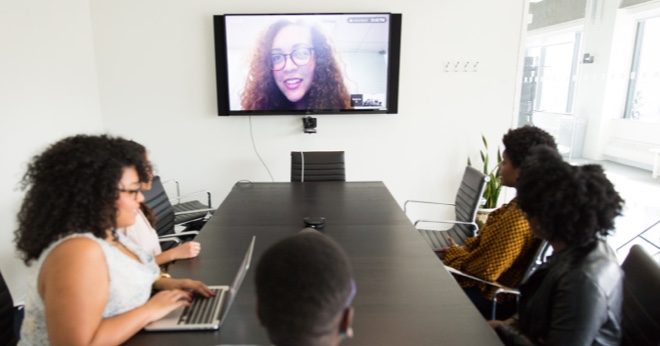Covid- 19, hybrid meetings, and productivity
As the COVID-19 pandemic still continues to shape the way we work, hybrid meetings – a meeting where some of the participants are physically present in the same location, while others are joining remotely, usually via video conferencing technology- have become the norm for many organizations. And thanks to hybrid meetings, workplaces are starting to become a lot more flexible. However, with some employees in the office and others joining remotely, maintaining productivity in these meetings can be a challenge.
As more workplaces move to a hybrid structure, one question at the forefront of many business leaders’ minds is how to maintain high productivity levels both at home and in the office. According to a study by the Harvard Business Review, “teams that hold effective meetings are more likely to make better decisions, experience higher levels of engagement, and deliver better results.” Additionally, meeting attendees are more inclined to buy into decisions when they’re engaged and feel that their voices are heard.
However, like any meeting, hybrid meetings can sometimes have issues, particularly for those joining virtually.
Reasons for unproductive hybrid meetings
1. Disorganisation
Organisation is key for productive hybrid meetings. Each attendee in a meeting should always be sent a brief beforehand – whether they are onsite or remote – so they are aware of what’s previously been discussed, and can concentrate on discussing solutions and future steps as soon as the meeting begins.
2. Audio / video issues
Remote employees sometimes can’t hear what is being said in the meeting room onsite because perhaps not everyone is sitting close enough to the laptop or screen’s microphone, or, a co-worker simply has a quiet speaking voice. Audio echo and distortion due to faulty internet connections can also occur. This can make it difficult for the remote employee to feel included in the conversation.
Remote employees can sometimes miss visual cues from facial expressions that happen in-office – for example, when someone is screensharing, you can’t see their face at all. Along with that, remote employees often don’t realise their video is frozen or glitching – which leads to awkwardness, distraction, and disjointedness in the conversation until the video quality improves.
3. Meeting bloat
When setting up a meeting, the people invited are just as important as the topic to be discussed. Even worse than inviting too many people to a meeting is inviting team members who don’t necessarily need to be there. Not only is it a waste of their valuable time, but it also means the meeting is unlikely to stay on track.
4. Communication and collaboration issues
When there are more people in the office than are joining remotely, remote attendees may feel excluded from the conversation, and in turn, may feel that their opinions and ideas don’t matter as much. Face-to-face communication has many advantages, including the ability to dynamically speak and read each other’s nonverbal cues. However, this is less likely to happen when you communicate with several people over a screen. It can be difficult for remote employees to know when to add a thought or to interject, so their contributions are often missed. According to a study from Owl Labs, 34% of people who participate remotely choose not to speak out when someone else is speaking.
Steps that could help improve hybrid meeting productivity
1. Set a specific agenda
An agenda will set expectations, outline a clear direction and give people a chance to prepare for the upcoming meeting. It’s important to share the agenda at least a few days ahead of the meeting. A better flow is created during the meeting when your thoughts are gathered in advance, which can streamline conversations. Having a clear agenda and sticking to it leaves more time for discussion, which will engage the people in the room much more than reciting a monologue. Let’s face it, monologues are only entertaining when they’re in a good play.
2. Use good quality, up to date tech solutions
It’s crucial to make sure you have the necessary technology to fit the practical and social needs for your hybrid meetings. Meeting room technology must be user-friendly. The technology should enable participants to share their screens and content seamlessly with other participants from a device of their choice. When you don’t have to worry about setting up for meetings and making sure your devices are compatible with the tech already in the room, focus and productivity increases, and your staff can communicate more efficiently with each other, which is the whole point of meeting centrally to share resources and information.
It is important to listen to your employees to ensure that the tools you are using are well-liked, up-to-date and user-friendly. You may find that a particular tool isn’t loved by employees or just isn’t a good fit for your business in general. Leveraging this information will help you improve your meeting technology in an effective way.
This is one of the reasons we developed Launcher – to act as an interface for the meeting room display, giving users simple access to their calls, calendars, and apps on the meeting room screen. Thanks to the ability to customize apps, your room users enjoy a consistent and standardized experience in every meeting space across your business. This improves user experience and confidence with using tech in the meeting space and reduces support requests.
3. Balance meeting equity
There should be no second-class citizens during a hybrid meeting. Remote attendees are not just listening in – they are valuable participants in the discussion, so it’s important to make sure they feel included in the meeting. This can be done by making sure they can hear and see all of the onsite attendees before the meeting begins – remote participants should have a view of the interaction and speakers in the meeting room and visa versa. Another way of increasing inclusivity in hybrid meetings is training in-person attendees on how to include remote attendees in the meeting discussion.
Make your meetings more productive with DisplayNote Launcher
With Launcher added to your meeting room screens, users have quick and easy access to all their calls (regardless of the platform) and favourite apps – without compromising on security or locking into a single UC vendor. Plus, with Launcher’s Kiosk Mode, IT Administrators are in control of what users can and can’t access on the meeting room system. You can easily customize the screen with the apps and tools you choose, so meeting room attendees can’t meddle with the settings or download any unapproved software.
Credit: DisplayNote Launcher

